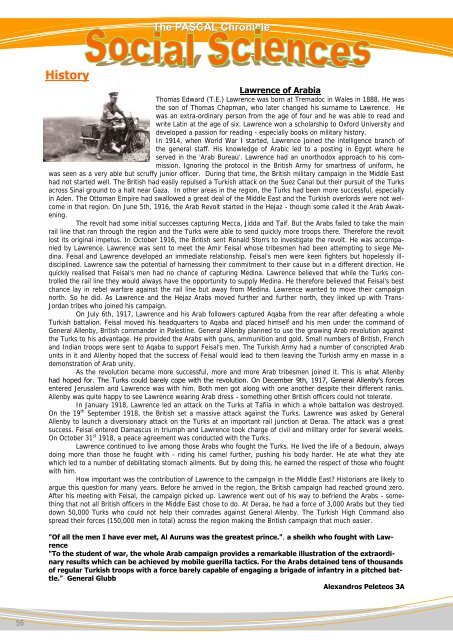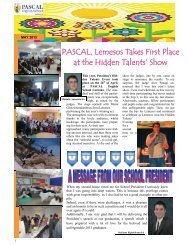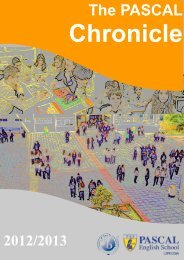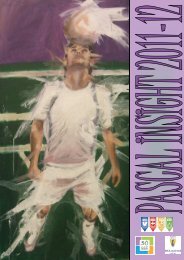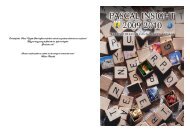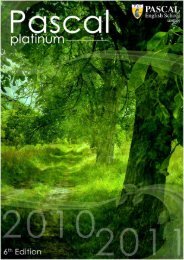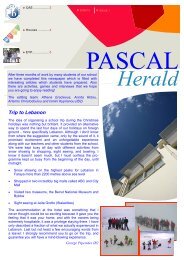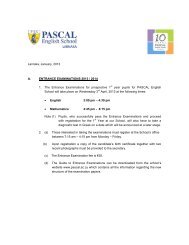Chronicle
PASCAL Chronicle 2011/12 - Pascal Education
PASCAL Chronicle 2011/12 - Pascal Education
Create successful ePaper yourself
Turn your PDF publications into a flip-book with our unique Google optimized e-Paper software.
The PASCAL <strong>Chronicle</strong>HistoryLawrence of ArabiaThomas Edward (T.E.) Lawrence was born at Tremadoc in Wales in 1888. He wasthe son of Thomas Chapman, who later changed his surname to Lawrence. Hewas an extra-ordinary person from the age of four and he was able to read andwrite Latin at the age of six. Lawrence won a scholarship to Oxford University anddeveloped a passion for reading - especially books on military history.In 1914, when World War I started, Lawrence joined the intelligence branch ofthe general staff. His knowledge of Arabic led to a posting in Egypt where heserved in the 'Arab Bureau'. Lawrence had an unorthodox approach to his commission.Ignoring the protocol in the British Army for smartness of uniform, hewas seen as a very able but scruffy junior officer. During that time, the British military campaign in the Middle Easthad not started well. The British had easily repulsed a Turkish attack on the Suez Canal but their pursuit of the Turksacross Sinai ground to a halt near Gaza. In other areas in the region, the Turks had been more successful, especiallyin Aden. The Ottoman Empire had swallowed a great deal of the Middle East and the Turkish overlords were not welcomein that region. On June 5th, 1916, the Arab Revolt started in the Hejaz - though some called it the Arab Awakening.The revolt had some initial successes capturing Mecca, Jidda and Taif. But the Arabs failed to take the mainrail line that ran through the region and the Turks were able to send quickly more troops there. Therefore the revoltlost its original impetus. In October 1916, the British sent Ronald Storrs to investigate the revolt. He was accompaniedby Lawrence. Lawrence was sent to meet the Amir Feisal whose tribesmen had been attempting to siege Medina.Feisal and Lawrence developed an immediate relationship. Feisal's men were keen fighters but hopelessly illdisciplined.Lawrence saw the potential of harnessing their commitment to their cause but in a different direction. Hequickly realised that Feisal's men had no chance of capturing Medina. Lawrence believed that while the Turks controlledthe rail line they would always have the opportunity to supply Medina. He therefore believed that Feisal's bestchance lay in rebel warfare against the rail line but away from Medina. Lawrence wanted to move their campaignnorth. So he did. As Lawrence and the Hejaz Arabs moved further and further north, they linked up with Trans-Jordan tribes who joined his campaign.On July 6th, 1917, Lawrence and his Arab followers captured Aqaba from the rear after defeating a wholeTurkish battalion. Feisal moved his headquarters to Aqaba and placed himself and his men under the command ofGeneral Allenby, British commander in Palestine. General Allenby planned to use the growing Arab revolution againstthe Turks to his advantage. He provided the Arabs with guns, ammunition and gold. Small numbers of British, Frenchand Indian troops were sent to Aqaba to support Feisal's men. The Turkish Army had a number of conscripted Arabunits in it and Allenby hoped that the success of Feisal would lead to them leaving the Turkish army en masse in ademonstration of Arab unity.As the revolution became more successful, more and more Arab tribesmen joined it. This is what Allenbyhad hoped for. The Turks could barely cope with the revolution. On December 9th, 1917, General Allenby‘s forcesentered Jerusalem and Lawrence was with him. Both men got along with one another despite their different ranks.Allenby was quite happy to see Lawrence wearing Arab dress - something other British officers could not tolerate.In January 1918, Lawrence led an attack on the Turks at Tafila in which a whole battalion was destroyed.On the 19 th September 1918, the British set a massive attack against the Turks. Lawrence was asked by GeneralAllenby to launch a diversionary attack on the Turks at an important rail junction at Deraa. The attack was a greatsuccess. Feisal entered Damascus in triumph and Lawrence took charge of civil and military order for several weeks.On October 31 st 1918, a peace agreement was conducted with the Turks.Lawrence continued to live among those Arabs who fought the Turks. He lived the life of a Bedouin, alwaysdoing more than those he fought with - riding his camel further, pushing his body harder. He ate what they atewhich led to a number of debilitating stomach ailments. But by doing this, he earned the respect of those who foughtwith him.How important was the contribution of Lawrence to the campaign in the Middle East? Historians are likely toargue this question for many years. Before he arrived in the region, the British campaign had reached ground zero.After his meeting with Feisal, the campaign picked up. Lawrence went out of his way to befriend the Arabs - somethingthat not all British officers in the Middle East chose to do. At Deraa, he had a force of 3,000 Arabs but they tieddown 50,000 Turks who could not help their comrades against General Allenby. The Turkish High Command alsospread their forces (150,000 men in total) across the region making the British campaign that much easier."Of all the men I have ever met, Al Auruns was the greatest prince.", a sheikh who fought with Lawrence"To the student of war, the whole Arab campaign provides a remarkable illustration of the extraordinaryresults which can be achieved by mobile guerilla tactics. For the Arabs detained tens of thousandsof regular Turkish troops with a force barely capable of engaging a brigade of infantry in a pitched battle."General GlubbAlexandros Peleteos 3A56


